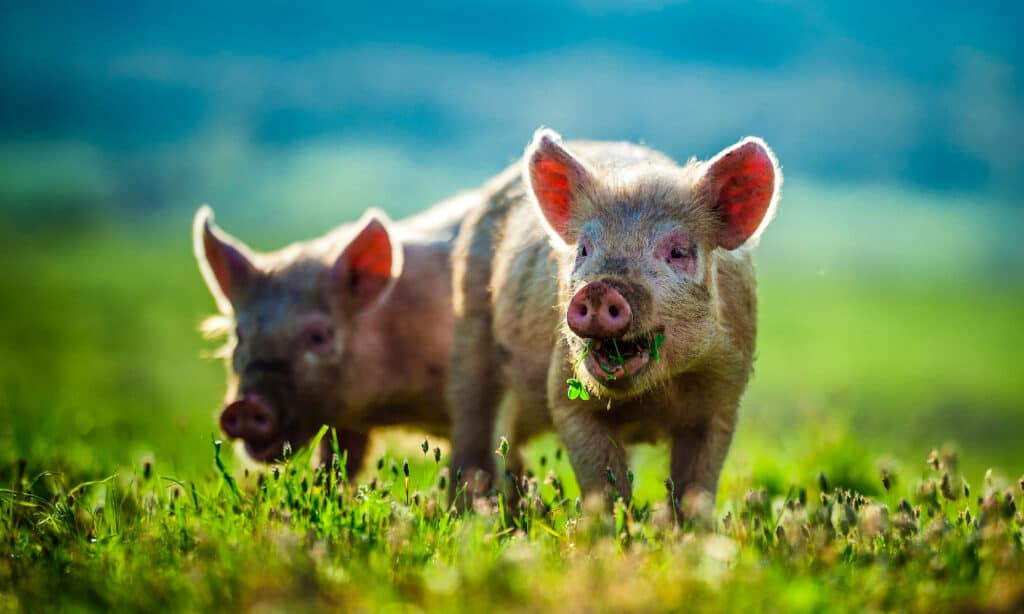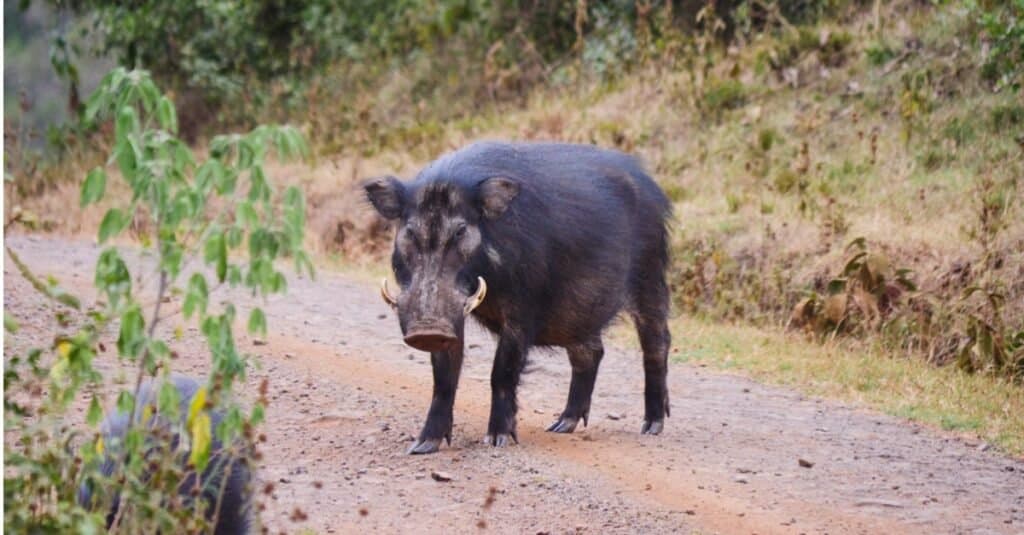As early as 9,000 years ago, humans domesticated wild hogs in Eurasia. As trade and transportation developed, people were able to transport them all across the globe. Today, many wild hogs have escaped captivity and have formed large feral populations in new areas.
Over the last several hundred years, wild hogs have established large populations across North America. They now reside comfortably in nearly every U.S. state, including Alabama where they are considered invasive. But how many are there in the state and where do they live? How did they become so established?

Humans domesticated wild Eurasian hogs millennia ago. Today, there are populations of domesticated hogs across the globe.
©Chumash Maxim/Shutterstock.com
History of Wild Hogs in the United States
There are no species of wild swine native to the continent of North America — every population of wild hog in North America is the result of introduction by settlers for farming or hunting purposes.
Pigs first arrived on the continent in the 1500s alongside early European colonizers who brought them overseas to raise for food. Due to fenceless livestock practices that have persisted in some U.S. states until recently, small populations of pigs escaped captivity and reverted to a wild form. It didn’t take long, either — released or escaped hogs quickly adapt to their wild environment and reproduce very quickly. Female hogs, once they have reached 6–8 months of age, can birth up to two litters per year. Considering that each litter consists on average of 4–8 piglets, it is easy to see how feral populations grew so quickly.
Much later, in the 1900s, people imported and released populations of the Russian wild hog with the intention of hunting them for sport. These released hogs then continued to breed with escaped hog populations, which only served to speed up the population boom. Since population tracking began in the 1980s, these versatile animals have spread their inhabited range to at least 35 states. Today, there are estimated to be over 6,000,000 wild hogs across the United States alone. And that number is continuing to grow!
How Many Wild Hogs Are in Alabama?
Current estimates suggest that there are at least 225,000 wild hogs in Alabama alone. Since their introduction to the state throughout the 17th and 18th centuries, they have spread across all of Alabama’s 67 counties. Despite growing efforts to control their populations, the number of hogs in the state continues to grow.
Can You Hunt Wild Hogs in Alabama?
Hunting of wild hogs is common practice in the state of Alabama. According to regulation, hunters may take hogs at night and often do so with bait and under red light. On private land, hunters can take hogs year-round without penalty. However, hunters on public land must adhere to local and seasonal laws and regulations, necessitating the purchase of a small game license. Because these animals are considered invasive in Alabama and their populations are increasing so rapidly, the state does not impose a bag limit on hunters.
Environmental Impact
These animals strongly impact the environments they inhabit. Because they cannot sweat, they roll in mud, or “wallow”, near water sources to help them keep cool. When they do this, they disrupt soils that then erode, washing nutrients and sediment into waterways. This can ultimately cause nutrient and bacterial pollution as well as decreased oxygenation of the water. Because they reproduce so quickly and affect their environment so drastically, people consider them invasive.
Facts About Wild Hogs
If you’re spending any time in the woods, whether you’re hunting or hiking, you should know how to identify wild hogs and be cautious and respectful of them in the areas they frequent.
What Do Wild Hogs Look Like?
Although they may look slightly different, wild and domesticated hogs actually belong to the same species — Sus scrofa.
Wild hogs closely resemble their domesticated relatives. However, because they are more mobile and must search for their food they tend to be leaner. Additionally, their coats are thicker and coarser, and their tusks tend to be much longer. Most adult wild hogs are about 5 feet long and range in weight from 75 to 250 pounds. Although they can reach weights of up to 500 pounds under the right circumstances, it is fairly rare.
Because they are the same species as domesticated hogs, wild hogs are able to interbreed with domesticated ones. As a result, their coloration can vary greatly. Many adult hogs are brown or black, but they can be red or white as well. Piglets often have striped or spotted coats to help them blend in with their environment, increasing their survival rate. This camouflage is incredibly effective, especially in woodland environments. As the hogs reach maturity, they lose these patterns in favor of more solid coloring.

While
wild boar
have intimidating tusks, they would rather avoid physical conflict with humans.
©iStock.com/chingkai huang
Where Do They Live?
Wild hogs are very opportunistic and adaptable animals. Because they are omnivorous, they are not confined to any specific area or habitat and tend to be fairly nomadic. Oftentimes, female hogs, called sows, roam in groups called sounders. These groups can range in size from a few sows and their offspring to as many as 30 members. Male hogs, called boars, generally live alone or in small groups and join sounders only to reproduce.
Because they cannot sweat to cool themselves in the summer heat, wild hogs in Alabama spend much of the daytime hours in the shade or near water sources. They also prefer environments that afford them plenty of cover. Woodlines, forests, and marshy areas are common habitats for these animals. As they travel and forage, they will often venture into agricultural fields and pastures.
If wild hogs are present in an area, it is usually pretty obvious. Their wallowing behavior along the sides of ponds, rivers, and streams leaves behind patches of disrupted soil and mud. Afterward, they will rub against nearby trees and rocks in an effort to remove dried mud and any parasites trapped within it.
In wet or soft ground, they leave tracks that resemble those of whitetail deer. In contrast, however, wild hog tracks tend to be rounder and wider in shape, having rounded toe tips and less of an overall point. Wild hogs also have dewclaws that point at an outward angle from the rear of the foot.
Are Wild Hogs Dangerous?
These animals are reputed to be particularly aggressive towards humans, especially during breeding seasons. However, this is not often the case. According to a study that looked at data recorded from 1825 to 2012, attacks on humans by wild hogs have been very, very rare. Over that period of time, there are only around 400 attacks on record.
The vast majority of these attacks — over 70% of them — occurred between 2000 and 2012. Nearly a third of the recorded attacks did not result in any physical harm to the humans involved. About 40% of them were the result of human threat to the hogs. Out of all of the attacks on record, only 4 were ever fatal and three of those fatal injuries were inflicted by wounded hogs.
The data shows that these animals are most likely to attack out of self-defense rather than unprovoked aggression. However, that doesn’t mean that they aren’t dangerous. It is still important to respect these animals in the wild and remember that they are capable of injuring you if they feel threatened.
Always be aware of your surroundings when out in the woods and give these animals the space they need. If you are hunting and your shot does not immediately kill your target hog, it is a good idea to let it run and recover it later. Most hunting-related injuries caused by hogs are caused in pursuit of the animal.
The photo featured at the top of this post is © iStock.com/xalanx
Thank you for reading! Have some feedback for us? Contact the AZ Animals editorial team.






